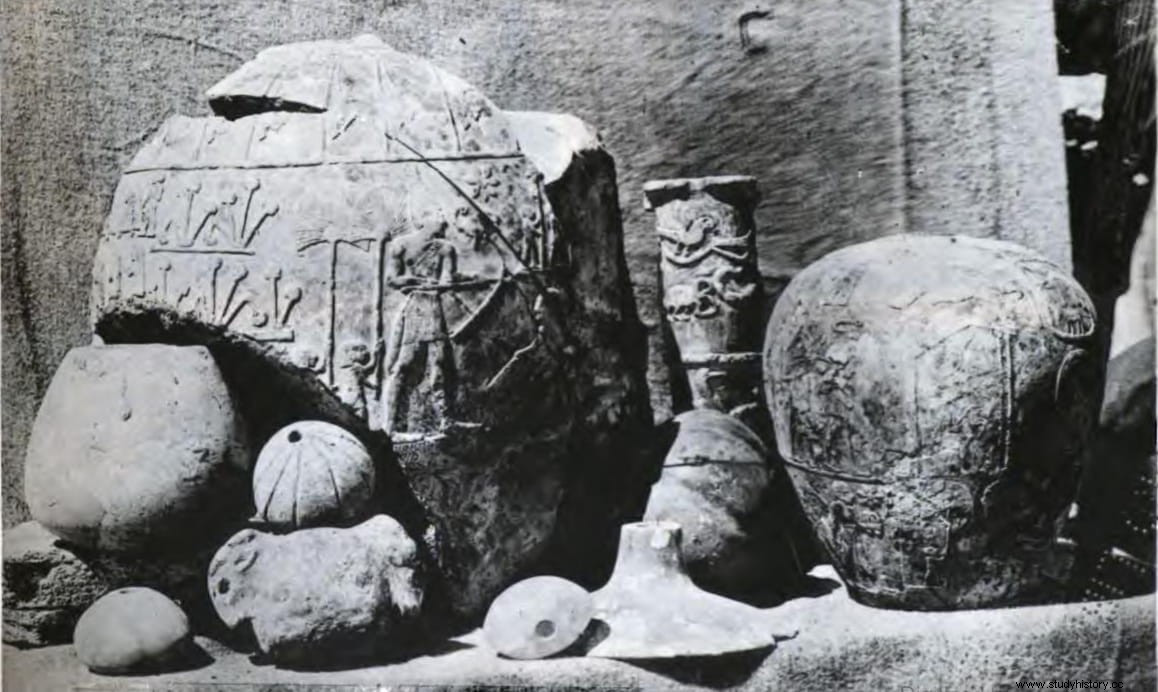In 1897 the British archaeologists James Quibell and Frederick W. Green were excavating the ruins of the city of Hierakonpolis (in ancient Egyptian called Nekhen, now Kim el-Ahmar), the capital of Upper Egypt until the end of the protodynastic period (between 3500 and 3100 BC approximately). There, under the Temple of Horus, they found a large cache of votive objects dating to the end of the Old Kingdom (2686-2181 BC), but containing much older objects that had been moved there later.
Among these objects was a limestone mace head, about 32.5 centimeters high, depicting a large pharaoh wearing the white crown of Upper Egypt. Next to it is engraved his name represented by the image of a scorpion. It is a ritual mace, about five times the size of a functional mace.
The king is shown standing with a bull's tail and next to a water course, possibly a canal, holding a hoe, symbolizing the ritual opening of the dikes after the flooding of the Nile or of a ditch for the foundation of a temple or city. . It is the oldest testimony of this rite, which will endure in Egyptian iconography until the Greek domination. He is facing a man with a basket that seems to drop seeds to the ground, another carrying a huge bundle of sheaves of grain, and others carrying banners. 
Some men appear to be performing tasks on the canal, while at the back of the king's retinue are papyrus plants, a group of women (perhaps dancers), and another small group of people with their backs to the pharaoh. In the upper right part of the king appears the dog Jentiamentiu, the god who protected the necropolis of Abydos.
In the upper register there is a row of banners from which hang rejit birds , lapwings that were originally used to refer to the inhabitants of the delta or Lower Egypt by the inhabitants of Upper Egypt.

All this is interpreted as the conquest of Lower Egypt, and some foreign countries, by a king named Horus Scorpion II who ruled around 3075 BC, better known as the Scorpion King (to differentiate him from another older king with the same name who ruled the Upper Egypt around 3250 BC, and about which not much is known either).
The presence of the Nine Arches, a symbol of foreigners and enemies that we already talked about in another article, would reinforce the hypothesis that it was this king who unified Egypt, and not his successor Narmer, as tradition says.
In this sense, another small fragment belonging to a second mace and found in the same deposit shows the same king with the red crown of Lower Egypt.
The mace head, which is now in the Ashmolean Museum in Oxford, United Kingdom, would be one of the oldest representations of an Egyptian king, and is the only graphic proof of the existence of the Scorpion King, of which no one has been found. no other historical information. It is also considered the oldest mace head found to date, dating from around 3075-3050 BC

The exact burial place of the Scorpion King is unknown. Researchers believe that his tomb may be either the one designated B50 in the Umm el-Qaab necropolis at Abydos, or the one designated HK6-1 at Hierakonpolis. The first is an almost square chamber divided into four rooms by a simple cross-shaped mud wall. The second measures 3.5 by 6.5 meters, is 2.5 meters deep and is reinforced with mud. In both, several ivory plaques with figures of scorpions have been found.
At the end of 2020 researchers from the University of Bonn together with the Egyptian Ministry of Antiquities deciphered the world's oldest place-name sign, a hieroglyphic inscription found in the Wadi el Malik east of Aswan which reads: domain of the Scorpion King of Horus , and which is believed to refer to this same king.

Some Egyptologists, such as Bernadette Menu, are of the opinion that since the Egyptian kings of the first dynasty seem to have had several names, Scorpion was the same person as Pharaoh Narmer, with a different name or additional title. In fact both seem to have been contemporary and the mace's artistic style bears intriguing similarities to a similar one from Narmer. For others, such as T. H. Wilkinson, Renée Friedman, and Bruce Trigger, the Scorpion King would be the ruler of a minor kingdom later conquered by Narmer to unify Egypt.
